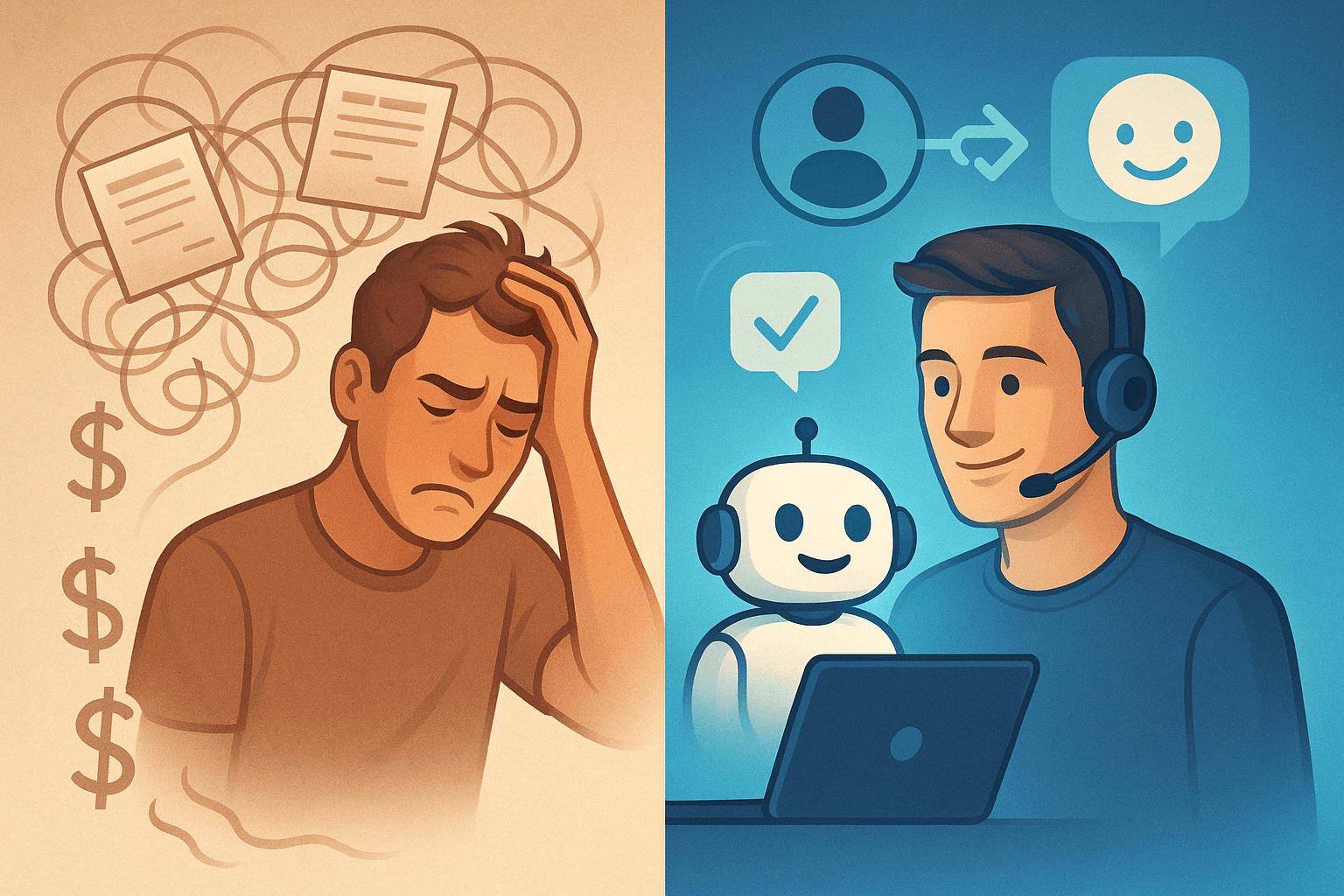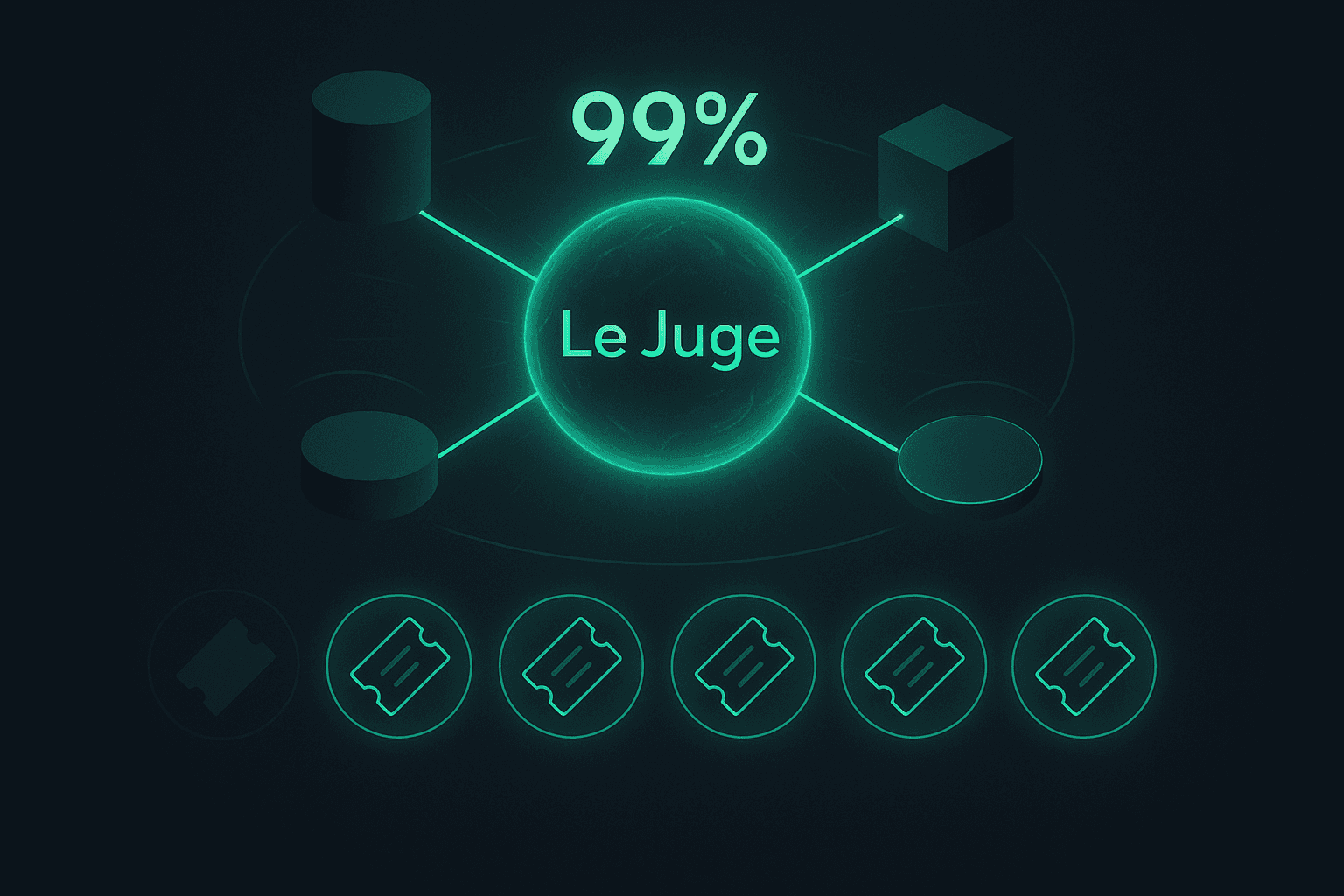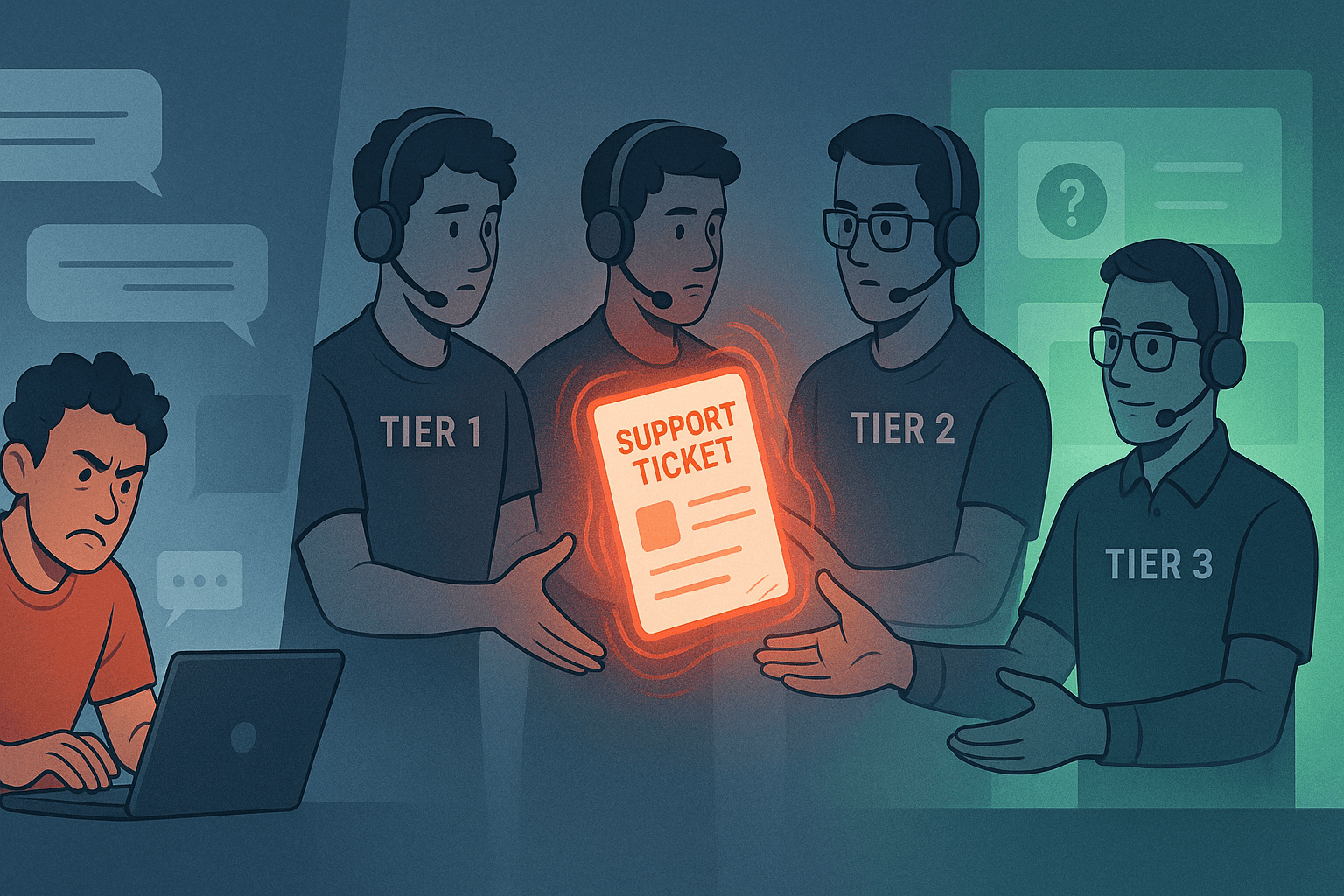Glossary
Why First Contact Resolution Still Bleeds Cash
First Contact Resolution failures drain budgets fast. Discover data‑backed tactics and see how Quivr’s AI lifts FCR and slashes support costs—book a demo today.
Content
Jul 13, 2025


The dashboard says your customer just closed a ticket. Great—until she calls back tomorrow because the refund never landed. Multiply that déjà‑vu moment by thousands of interactions and the math hurts: at $3–$9 per resolution, with a $5 industry average, every avoidable follow‑up drains profit and patience. Here’s the kicker: First Contact Resolution (FCR) hovers below 70 % for most operations, meaning nearly one‑third of customers need to “try again.” What if you could claw that money back and delight customers in the same stroke?
The Illusion of Automation Savings
Automation dashboards glow green, yet many CFOs still sign off on bloated support budgets. Truth is, only best‑fit AI slashes cost per call—one leading deployment cut it 50 % while boosting CSAT . The rest? They shuffle tickets to humans and rack up rework.
Bots misclassify intent, escalating anyway.
Knowledge bases age faster than release cycles.
Agents redo 60–70 % of escalations.
Licence creep hides in “all‑in‑one” suites.
If your CFO thinks the cost line is flat, are you sure the repeat‑contact iceberg isn’t hiding beneath? Bridge → Traditional chatbots are the weak link customers feel first.
Why Traditional Chatbots Break Down
Customers tolerate scripted bots—until stakes rise. 57 % have abandoned a purchase after poor bot support, and 39 % say repeating the issue is their top frustration . Worse, 70 % would switch brands after a single bad AI interaction .
Context resets mid‑conversation.
Confidence scores stay opaque; bots answer even when unsure.
Handoffs drop the transcript, forcing customers to start over.
Emotional cues—anger, anxiety, urgency—go unnoticed.
If shoppers bolt that quickly, what’s the lifetime‑value haircut you’re taking today? Bridge → Repeat contacts don’t just bruise NPS; they torch hard cash.
The Hidden Expense of Repeat Contacts
Industry “good” FCR runs 70–79 %, but the average sits just under 70 %. Do the math: with 10 000 monthly tickets at $5 each, every 1‑point drop below 70 % leaks $50 000 a year—and each 1 % FCR gain saves $286 000 in a midsize center.
Agents reopen cases, doubling handle time.
Customers vent on public channels, spiking churn risk.
Supervisors audit calls, adding labor overhead.
Forecasting skews high, so you overstaff “just in case.”
Vendor contracts scale with volume, not success.
CX reports mask the snowball by counting “tickets closed,” not “issues resolved.”
If one extra contact can cost five bucks today, what could chronic repeats cost your share price tomorrow? Let’s look at operations where FCR is a bragging right, not a problem statement.
What World‑Class Support Actually Feels Like
Top performers make the experience invisible; customers remember outcomes, not effort. The playbook shares three traits:
Context continuity: Every touchpoint flows into a single timeline.
Retrieval‑augmented answers: Knowledge pulls from live docs, not stale PDFs.
Human‑in‑the‑loop feedback: Agents overwrite AI drafts in seconds, training the model daily.
“When support feels like mind‑reading, loyalty follows.” — We tell every new customer this truth.
Could your brand voice survive if every misfire became a Reddit thread overnight? That’s why we built Quivr to solve the repeat‑contact disease at the root.
How Quivr Reinvents the Rules
We designed Quivr for teams who refuse to trade quality for automation.
98.5 % response accuracy—the model self‑censors unless confident, so wrong answers never leave draft.
2‑minute connectors to Zendesk, Gorgias, Intercom and Freshdesk—no extra IT sprint.
RAG + confidence gating: Live data retrieval means answers match today’s inventory, not last month’s SOP.
30 % safe automation ceiling: We only take the low‑risk tier, protecting CSAT while shrinking volume.
Open source & dev‑friendly: Fully hosted or self‑hosted, API‑first for rapid extension.
“We didn’t cut headcount—we cut handle time.” — Trusk Operations Lead, after Quivr began deflecting hundreds of daily tickets while keeping satisfaction high.
If our AI refuses to answer when unsure, how many brand‑damaging slips disappear overnight? Bridge → Let’s talk dollars.
What This Means for Your Bottom Line
Raise FCR by just 5 points and you bank roughly $1.4 million in annual savings on a 100‑seat center (math: $286 000 × 5). Layer on Quivr’s 30 % ticket deflection and the CFO sees a double hit: lower cost per resolution and happier customers who churn less. Imagine reinvesting that budget in proactive CX rather than patch‑up callbacks.
Ignoring First Contact Resolution is paying twice for the same problem—once in agent hours, again in customer loyalty. The next CX leaders will fuse high‑precision AI with empowered humans to make repeat contacts fade into history. Ready to plug the leak and free your team for work that matters?
Request a 15‑minute demo to see Quivr in action.
Similar Blogs
Glossary
Why First Contact Resolution Still Bleeds Cash
First Contact Resolution failures drain budgets fast. Discover data‑backed tactics and see how Quivr’s AI lifts FCR and slashes support costs—book a demo today.
Jul 13, 2025

The dashboard says your customer just closed a ticket. Great—until she calls back tomorrow because the refund never landed. Multiply that déjà‑vu moment by thousands of interactions and the math hurts: at $3–$9 per resolution, with a $5 industry average, every avoidable follow‑up drains profit and patience. Here’s the kicker: First Contact Resolution (FCR) hovers below 70 % for most operations, meaning nearly one‑third of customers need to “try again.” What if you could claw that money back and delight customers in the same stroke?
The Illusion of Automation Savings
Automation dashboards glow green, yet many CFOs still sign off on bloated support budgets. Truth is, only best‑fit AI slashes cost per call—one leading deployment cut it 50 % while boosting CSAT . The rest? They shuffle tickets to humans and rack up rework.
Bots misclassify intent, escalating anyway.
Knowledge bases age faster than release cycles.
Agents redo 60–70 % of escalations.
Licence creep hides in “all‑in‑one” suites.
If your CFO thinks the cost line is flat, are you sure the repeat‑contact iceberg isn’t hiding beneath? Bridge → Traditional chatbots are the weak link customers feel first.
Why Traditional Chatbots Break Down
Customers tolerate scripted bots—until stakes rise. 57 % have abandoned a purchase after poor bot support, and 39 % say repeating the issue is their top frustration . Worse, 70 % would switch brands after a single bad AI interaction .
Context resets mid‑conversation.
Confidence scores stay opaque; bots answer even when unsure.
Handoffs drop the transcript, forcing customers to start over.
Emotional cues—anger, anxiety, urgency—go unnoticed.
If shoppers bolt that quickly, what’s the lifetime‑value haircut you’re taking today? Bridge → Repeat contacts don’t just bruise NPS; they torch hard cash.
The Hidden Expense of Repeat Contacts
Industry “good” FCR runs 70–79 %, but the average sits just under 70 %. Do the math: with 10 000 monthly tickets at $5 each, every 1‑point drop below 70 % leaks $50 000 a year—and each 1 % FCR gain saves $286 000 in a midsize center.
Agents reopen cases, doubling handle time.
Customers vent on public channels, spiking churn risk.
Supervisors audit calls, adding labor overhead.
Forecasting skews high, so you overstaff “just in case.”
Vendor contracts scale with volume, not success.
CX reports mask the snowball by counting “tickets closed,” not “issues resolved.”
If one extra contact can cost five bucks today, what could chronic repeats cost your share price tomorrow? Let’s look at operations where FCR is a bragging right, not a problem statement.
What World‑Class Support Actually Feels Like
Top performers make the experience invisible; customers remember outcomes, not effort. The playbook shares three traits:
Context continuity: Every touchpoint flows into a single timeline.
Retrieval‑augmented answers: Knowledge pulls from live docs, not stale PDFs.
Human‑in‑the‑loop feedback: Agents overwrite AI drafts in seconds, training the model daily.
“When support feels like mind‑reading, loyalty follows.” — We tell every new customer this truth.
Could your brand voice survive if every misfire became a Reddit thread overnight? That’s why we built Quivr to solve the repeat‑contact disease at the root.
How Quivr Reinvents the Rules
We designed Quivr for teams who refuse to trade quality for automation.
98.5 % response accuracy—the model self‑censors unless confident, so wrong answers never leave draft.
2‑minute connectors to Zendesk, Gorgias, Intercom and Freshdesk—no extra IT sprint.
RAG + confidence gating: Live data retrieval means answers match today’s inventory, not last month’s SOP.
30 % safe automation ceiling: We only take the low‑risk tier, protecting CSAT while shrinking volume.
Open source & dev‑friendly: Fully hosted or self‑hosted, API‑first for rapid extension.
“We didn’t cut headcount—we cut handle time.” — Trusk Operations Lead, after Quivr began deflecting hundreds of daily tickets while keeping satisfaction high.
If our AI refuses to answer when unsure, how many brand‑damaging slips disappear overnight? Bridge → Let’s talk dollars.
What This Means for Your Bottom Line
Raise FCR by just 5 points and you bank roughly $1.4 million in annual savings on a 100‑seat center (math: $286 000 × 5). Layer on Quivr’s 30 % ticket deflection and the CFO sees a double hit: lower cost per resolution and happier customers who churn less. Imagine reinvesting that budget in proactive CX rather than patch‑up callbacks.
Ignoring First Contact Resolution is paying twice for the same problem—once in agent hours, again in customer loyalty. The next CX leaders will fuse high‑precision AI with empowered humans to make repeat contacts fade into history. Ready to plug the leak and free your team for work that matters?
Request a 15‑minute demo to see Quivr in action.



